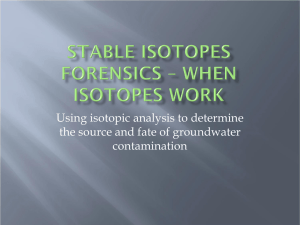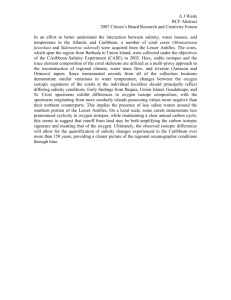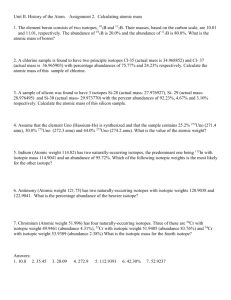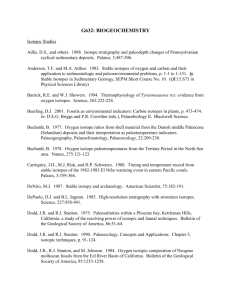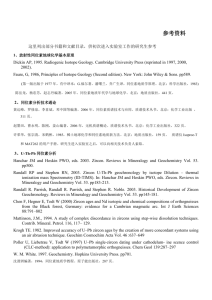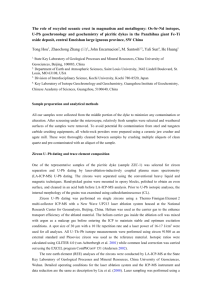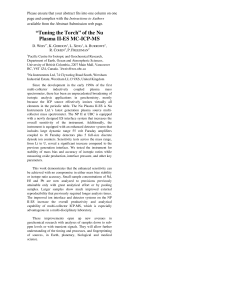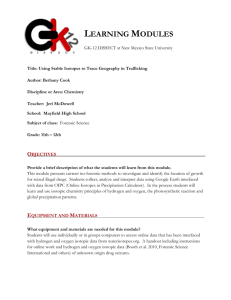Isotope distributions
advertisement
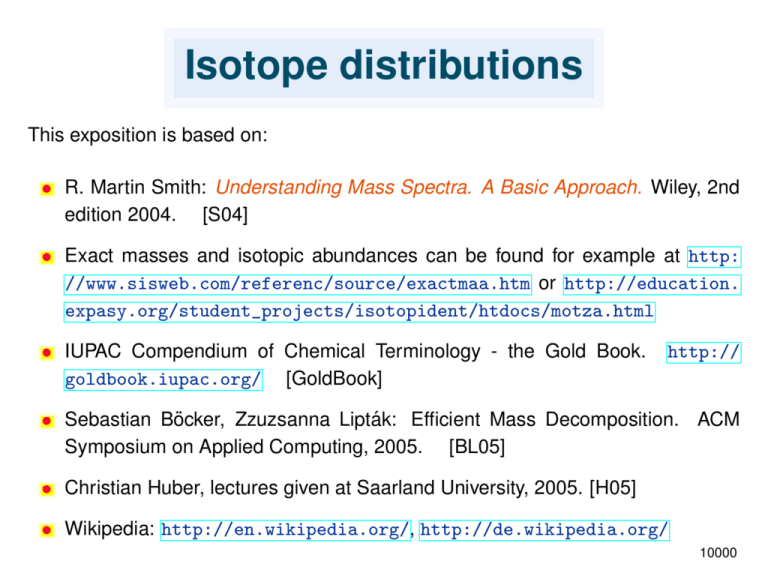
Isotope distributions
This exposition is based on:
• R. Martin Smith: Understanding Mass Spectra. A Basic Approach. Wiley, 2nd
edition 2004. [S04]
• Exact masses and isotopic abundances can be found for example at http:
//www.sisweb.com/referenc/source/exactmaa.htm or http://education.
expasy.org/student_projects/isotopident/htdocs/motza.html
• IUPAC Compendium of Chemical Terminology - the Gold Book.
goldbook.iupac.org/ [GoldBook]
http://
• Sebastian Böcker, Zzuzsanna Lipták: Efficient Mass Decomposition. ACM
Symposium on Applied Computing, 2005. [BL05]
• Christian Huber, lectures given at Saarland University, 2005. [H05]
• Wikipedia: http://en.wikipedia.org/, http://de.wikipedia.org/
10000
Isotopes
This lecture addresses some more combinatorial aspect of mass spectrometry related to isotope distributions and mass decomposition.
Most elements occur in nature as a mixture of isotopes. Isotopes are atom species
of the same chemical element that have different masses. They have the same
number of protons and electrons, but a different number of neutrons. The main elements occurring in proteins are CHNOPS. A list of their naturally occurring isotopes
is given below.
Isotope Mass [Da] % Abundance
1H
2H
1.007825 99.985
2.014102 0.015
12 C
12. (exact) 98.90
13 C 13.003355
1.10
14 N
14.003074 99.63
15 N 15.000109
0.37
Isotope Mass [Da] % Abundance
16 O
15.994915
17 O 16.999131
18 O 17.999159
31 P
32 S
99.76
0.038
0.20
30.973763 100.
31.972072
33 S 32.971459
34 S 33.967868
95.02
0.75
4.21
10001
Isotopes
(2)
Note that the lightest isotope is also the most abundant one for these elements.
Here is a list of the heavy isotopes, sorted by abundance:
Isotope Mass [Da] % Abundance
34 S
13 C
33 S
15 N
18 O
17 O
2H
33.967868
13.003355
32.971459
15.000109
17.999159
16.999131
2.014102
4.21
1.10
0.75
0.37
0.20
0.038
0.015
We see that sulfur has a big impact on the isotope distribution. But it is not always
present in a peptide (only the amino acids Cystein or Methionin contain sulfur).
Apart from that, 13C is most abundant, followed by 15N. These isotopes lead to
“+1” peaks. The heavy isotopes 18O and 34S lead to “+2” peaks. Note that 17O and
2 H are very rare.
10002
Isotopes
(3)
The two isotopes of hydrogen have special names: 1H is called protium, and 2H = D
is called deuterium (or sometimes “heavy” hydrogen).
Note that whereas the exact masses are universal physical constants, the relative
abundances are different at each place on earth and can in fact be used to trace the
origin of substances. They are also being used in isotopic labeling techniques.
The standard unit of mass, the unified atomic mass unit, is defined as 1/12 of the
mass of 12C and denoted by u or Da, for Dalton. Hence the atomic mass of 12C
is 12 u by definition. The atomic masses of the isotopes of all the other elements
are determined as ratios against this standard, leading to non-integral values for
essentially all of them.
The subtle differences of masses are due to the mass defect (essentially, the binding energy of the nucleus). We will return to this topic later. For understanding the
next few slides, the difference between nominal and exact masses is not essential.
10003
Isotopes
(4)
The average atomic mass (also called the average atomic weight or just atomic
weight) of an element is defined as the weighted average of the masses of all its
naturally occurring stable isotopes.
For example, the average atomic mass of carbon is calculated as
(98.9% ∗ 12.0 + 1.1% ∗ 13.003355) .
= 12.011
100%
For most purposes such as weighing out bulk chemicals only the average molecular
mass is relevant since what one is weighing is a statistical distribution of varying
isotopic compositions.
The monoisotopic mass is the sum of the masses of the atoms in a molecule using
the principle isotope mass of each atom instead of the isotope averaged atomic
mass and is most often used in mass spectrometry. The monoisotopic mass of
carbon is 12.
10004
Isotopes
(5)
According to the [GoldBook] the principal ion in mass spectrometry is a molecular or
fragment ion which is made up of the most abundant isotopes of each of its atomic
constituents.
Sometimes compounds are used that have been artificially isotopically enriched
in one or more positions, for example CH313CH3 or CH2D 2. In these cases the
principal ion may be defined by treating the heavy isotopes as new atomic species.
Thus, in the above two examples, the principal ions would have masses 31 (not 30)
and 18 (not 16), respectively.
In the same vein, the monoisotopic mass spectrum is defined as a spectrum containing only ions made up of the principal isotopes of atoms making up the original
molecule.
You will see that the monoisotopic mass is sometimes defined using the lightest
isotope. In most cases the distinction between ”principle” and ”lightest” isotope
is non-existent, but there is a difference for some elements, for example iron and
argon.
10005
Isotopic distributions
The mass spectral peak representing the monoisotopic mass is not always the most
abundant isotopic peak in a spectrum – although it stems from the most abundant
isotope of each atom type.
This is due to the fact that as the number of atoms in a molecule increases the
probability of the entire molecule containing at least one heavy isotope increases.
For example, if there are 100 carbon atoms in a molecule, each of which has an
approximately 1% chance of being a heavy isotope, then the whole molecule is not
unlikely to contain at least one heavy isotope.
The monoisotopic peak is sometimes not observable due to two primary reasons.
• The monoisotopic peak may not be resolved from the other isotopic peaks. In
this case only the average molecular mass may be observed.
• Even if the isotopic peaks are resolved, the monoisotopic peak may be below
the noise level and heavy isotopomers may dominate completely.
10006
Isotopic distributions
(2)
Terminology
10007
Isotopic distributions
(3)
Example:
10008
Isotopic distributions
(4)
To summarize: Learn to distinguish the following concepts!
• nominal mass
• monoisotopic mass
• most abundant mass
• average mass
10009
Isotopic distributions
(5)
Example: Isotopic distribution of human myoglobin
Screen shot: http://education.expasy.org/student_projects/isotopident/
10010
Isotopic distributions
(6)
A basic computational task is:
• Given an ion whose atomic composition is known, how can we compute its
isotopic distribution?
We will ignore the mass defects for a moment. It is convenient to number the peaks
by their number of additional mass units, starting with zero for the lowest isotopic
peak. We can call this the isotopic rank.
Let E be a chemical element. Let πE [i] denote the probability of the isotope of E
having i additional mass units. Thus the relative intensities of the isotopic peaks for
a single atom of element E are (πE [0], πE [1], πE [2], ..., πE [kE ]). Here kE denotes
the isotopic rank of the heaviest isotope occurring in nature. We have πE [`] = 0 for
` > k.
For example carbon has πC [0] = 98.9% = 0.989 (isotope 12C) and πC [1] = 1.1% =
0.011 (isotope 13C).
10011
Isotopic distributions
(7)
The probability that a molecule composed out of one atom of element E and one
atom of element E 0 has a total of n additional neutrons is
πEE 0 [n] =
n
X
πE [i] πE 0 [n − i] .
i=0
Note that πEE 0 [`] = 0 for ` > kE + kE0 .
This type of composition is very common in mathematics and known as a convolution operation, denoted by the operator ∗.
Using the convolution operator, we can rewrite the above equation as
πEE 0 = πE ∗ πE 0 .
For example, a hypothetical molecule composed out of one carbon and one nitrogen
would have πCN = πC ∗ πN ,
πCN [0] = πC [0]πN [0] ,
πCN [1] = πC [0]πN [1] + πC [1]πN [0] ,
πCN [2] = πC [0]πN [2] + πC [1]πN [1] + πC [2]πN [0]
= πC [1]πN [1] .
10012
Isotopic distributions
(8)
Clearly the same type of formula applies if we compose a larger molecule out of
smaller molecules or single atoms. Molecules have isotopic distributions just like
elements.
For simplicity, let us define convolution powers. Let ρ1 := ρ and ρn := ρn−1 ∗ ρ, for
any isotopic distribution ρ. Moreover, it is natural to define ρ0 by ρ0[0] = 1, ρ0[`] = 0
for ` > 0. This way, ρ0 will act as neutral element with respect to the convolution
operator ∗, as expected.
Then the isotopic distribution of a molecule with the chemical formula En11 · · · En`` ,
composed out of the elements E 1, ... , E `, can be calculated as
n
n
πE 1 ···E ` = πE1 ∗ ... ∗ πE` .
`
1
n1
n`
10013
Isotopic distributions
(9)
This immediately leads to an algorithm. for computing the isotopic distribution of a
molecule.
n
n
Now let us estimate the running time for computing πE1 ∗ ... ∗ πEl .
1
l
• The number of convolution operations is n1 + ... + nl − 1, which is linear in the
number of atoms.
• Each convolution operation involves a summation for each π[i]. If the highest
isotopic rank for E is kE , then the highest isotopic rank for En is kE n. Again,
this in linear in the number of atoms.
We can improve on both of these factors.
Do you see how?
10014
Isotopic distributions
(10)
Bounding the range of isotopes
For practical cases, it is possible to restrict the summation range in the convolution
operation.
In principle it is possible to form a molecule solely out of the heaviest isotopes,
and this determines the summation range needed in the convolution calculations.
However, the abundance of such an isotopomer is vanishingly small. In fact, it will
soon fall below the inverse of the Avogadro number (6.0221415 × 1023), so we will
hardly ever see a single molecule of this type.
For simplicity, we let us first consider a single element E and assume that kE = 1.
(For example, E could be carbon or nitrogen.) In this case the isotopic distribution
is a binomial with parameter p := πE [1],
πE n [k ] =
n pk (1 − p)n−k .
k
The mean of this binomial distribution is pn. Large deviations can be bounded as
follows.
10015
Isotopic distributions
(11)
We use the upper bound for binomial coefficients
ne k
.
≤
k
k
For k ≥ 3pn (that is, k three times larger than expected) we get
n n k
pk ≤
nep
2pn
!k
=
k
e
3
.
and hence
n n k
X
X
n k
e
n−k
p (1 − p)
≤
= O
k
3
`≥3pn
`≥3pn
3pn !
e
3
= o(1) .
While 3pn is still linear in n, it is much smaller – in practice one can usually restrict
the calculations to less than 10 isotopic variants for peptides.
Fortunately, if it turns out that the chosen range was too small, we can detect this
afterwards because the probabilities will no longer add up to 1. (Exercise: Explain
why.) Thus we even have an ‘a posteriori error estimate’.
10016
Isotopic distributions
(12)
More generally, a peptide is composed out of the elements C, H, N, O, S. For each
of these elements the lightest isotope has a natural abundance above 95% and the
highest isotopic rank is at most 2. Again we can bound the sum of the abundances
of heavy isotopic variants by a binomial distribution:
X
j≥i
πE 1 ···E ` [j] ≤
n1
n`
X n j≥i/2
j
0.05j 0.95n−j .
(In order to get i additional mass units, at least i/2 of the atoms must be ‘heavy’.)
10017
Isotopic distributions
(13)
Computing convolution powers by iterated squaring
There is another trick which can be used to save the number of convolutions needed
to calculate the n-th convolution power π n of an elemental isotope distribution.
Observe that just like for any associative operation ∗, the convolution powers satisfy
π 2n = π n ∗ π n .
In general, n is not a power of two, so let (bj , bj−1, ... , b0) be the bits of the binary
representation of n, that is,
n=
j
X
b`2` = bj 2j + bj−12j−1 + · · · + b020 .
`=0
Then we can compute π n as follows:
P j
Y 2j b
n
j 2 bj
j
π =π
=
π
= π
bj 2j
∗π
bj−1 2j−1
0
b
2
0
∗ ··· ∗ π
,
j
where the is of course meant with respect to ∗. The total number of convolutions
needed for this calculation is only O(log n).
Q
10018
Isotopic distributions
To summarize: The first k + 1 abundances π
n
n
n
E1n ···E` `
(14)
[i], i = 0, ... , k, of the isotopic
distribution of a molecule E1 1 · · · E` ` can be computed in O(`k log n) time and O(`k )
space, where n = n1 + ... + n`.
(Exercise: To test your understanding, check how these resource bounds follow
from what has been said above.)
10019
Mass decomposition
A related question is:
• Given a peak mass, what can we say about the elemental composition of the
ion that generated it?
In most cases, one cannot obtain much information about the chemical structural
from just a single peak. The best we can hope for is to obtain the chemical formula
with isotopic information attached to it. In this sense, the total mass of an ion is decomposed into the masses of its constituents, hence the term mass decomposition.
10020
Mass decomposition
(2)
This is formalized by the concept of a compomer [BL05].
We are given an alphabet Σ of size |Σ| = k, where each letter has a mass ai ,
i = 1, ... , k. These letters can represent atom types, isotopes, or amino acids, or
nucleotides. We assume that all masses are different, because otherwise we could
never distinguish them anyway. Thus we can identify each letter with its mass, i. e.,
Σ = {a1, ... , ak } ⊂ N. This is sometimes called a weighted alphabet.
The mass of a string s = s1 ... sn ∈ Σ∗ is defined as the sum of the masses of its
P|s|
letters, i. e., mass(s) = i=1 si .
Formally, a compomer is an integer vector c = (c1, ... , ck ) ∈ (N0)k . Each ci
represents the number of occurrences of letter ai . The mass of a compomer is
P
P
mass(c) := ki=1 ci ai , as opposed to its length, |c| := ki=1 ci .
In short: A compomer tells us how many instances of an atomic species are present
in a molecule. We want to find all compomers whose mass is equal to the observed
mass.
10021
Mass decomposition
(3)
There a many more strings (molecules) than compomers, but the compomers are
still many.
For a string s = s1 ... sn ∈ Σ∗, we define comp(s) := (c1, ... , ck ), where ci :=
#{j | sj = ai }. Then comp(s) is the compomer associated with s, and vice versa.
One can prove (exercise):
|c|
1. The number of strings associated with a compomer c = (c1, ... , ck ) is c ,...,c
1
k
|c|!
c1 !···ck ! .
=
2. Given
an
integer n, the number of compomers c = (c1, ... , ck ) with |c| = n is
n+k −1
k −1 .
Thus a simple enumeration will not suffice for larger instances.
10022
Mass decomposition
(4)
Using dynamic programming, we can solve the following problems efficiently
(Σ: weighted alphabet, M: mass):
1. Existence problem: Decide whether a compomers c with mass(c) = M exists.
2. One Witness problem: Output a compomer c with mass(c) = M, if one exists.
3. All witnesses problem: Compute all compomers c with mass(c) = M.
10023
Mass decomposition
(5)
The dynamic programming algorithm is a variation of the classical algorithm originally introduced for the ‘Coin Change Problem’, originally due to Gilmore and Gomory.
Given a query mass M, a two-dimensional Boolean table B of size kM is constructed
such that
B[i, m] = 1 ⇐⇒ m is decomposable over {a1, ... , ai } .
The table can be computed with the following recursion:
B[1, m] = 1 ⇐⇒ m
mod a1 = 0
and for i > 0,
B[i − 1, m]
B[i, m] =
B[i − 1, m] ∨ B[i, m − a ]
i
m < ai ,
otherwise .
The table is constructed up to mass M, and then a straight-forward backtracking
algorithm computes all witnesses of M.
10024
Mass decomposition
(6)
For the Existence and One Witness Problems, it suffices to construct a onedimensional Boolean table A of size M, using the recursion A[0] = 1, A[m] = 0
for 1 ≤ m < a1; and for m ≥ a1, A[m] = 1 if there exists an i with 1 ≤ i ≤ k
such that A[m − ai ] = 1, and 0 otherwise. The construction time is O(kM) and one
witness c can be produced by backtracking in time proportional to |c|, which can be
in the worst case a1 M. Of course, both of these problems can also be solved using
1
the full table B.
A variant computes γ(M), the number of decompositions of M, in the last row, where
the entries are integers, using the recursion C[i, m] = C[i − 1, m] + C[i, m − ai ].
The running time for solving the All Witnesses Problem is O(kM) for the table construction, and O(γ(M) a1 M) for the computation of the witnesses (where γ(M) is the
1
size of the output set), while storage space is (O(kM).
10025
Mass decomposition
(7)
The number of compomers is O(M Σ). (Exercise: why?) Depending on the mass
resolution, the results can be useful for M up to, say, 1000 Da, but in general one
has to take further criteria into account. (Figure from [BL].)
10026
Mass decomposition
(8)
Example output from http://bibiserv.techfak.uni-bielefeld.de/decomp/
#
#
#
#
#
#
#
#
#
#
#
#
#
#
#
#
#
#
#
#
#
#
#
#
#
imsdecomp 1.3
Copyright 2007,2008 Informatics for Mass Spectrometry group
at Bielefeld University
http://BiBiServ.TechFak.Uni-Bielefeld.DE/decomp/
precision: 4e-05
allowed error: 0.1 Da
mass mode: mono
modifiers: none
fixed modifications: none
variable modifications: none
alphabet (character, mass, integer mass):
H 1.007825
25196
C
12
300000
N 14.003074
350077
O 15.994915
399873
P 30.973761
774344
S 31.972071
799302
constraints: none
chemical plausibility check: off
Shown in parentheses after each decomposition:
- actual mass
- deviation from actual mass
10027
#
# mass 218.03 has 1626 decompositions (showing the best 100):
H2 C6 N8 O2 (218.03007; +7.1384e-05)
H8 C7 N1 O7 (218.03008; +7.6606e-05)
H13 C2 N5 O1 P1 S2 (218.02991; -8.7014e-05)
H139 O1 P2 (218.03012; +0.000117068)
H19 C1 N1 O3 P3 S1 (218.02985; -0.000151322)
H16 N3 O4 S3 (218.03029; +0.000293122)
H5 C2 N9 O2 P1 (218.03038; +0.00038199)
H11 C3 N2 O7 P1 (218.03039; +0.000387212)
H10 C6 N4 O1 S2 (218.0296; -0.00039762)
H16 C5 O3 P2 S1 (218.02954; -0.000461928)
H16 C3 N3 P4 (218.02947; -0.000531458)
H21 C2 N1 P1 S4 (218.02944; -0.000556018)
H8 N7 O5 S1 (218.03076; +0.000762126)
H14 C1 O10 S1 (218.03077; +0.000767348)
H18 C5 O1 P4 (218.03081; +0.000811196)
H13 C7 N2 P3 (218.02916; -0.000842064)
H18 C6 S4 (218.02913; -0.000866624)
H12 C8 N1 O2 S2 (218.03095; +0.000945034)
H9 C1 N5 O6 P1 (218.02904; -0.000955442)
H3 N12 O1 P1 (218.02904; -0.000960664)
H21 C1 N1 O1 P5 (218.03112; +0.001121802)
H10 C11 N1 P2 (218.02885; -0.00115267)
H137 O3 S1 (218.02884; -0.001156056)
H15 C4 N2 O2 P1 S2 (218.03126; +0.00125564)
H6 C5 N4 O6 (218.02873; -0.001266048)
C4 N11 O1 (218.02873; -0.00127127)
H4 C8 N5 O3 (218.03141; +0.001414038)
H17 C1 N1 O5 P1 S2 (218.02858; -0.001424446)
H11 N8 P1 S2 (218.02857; -0.001429668)
H7 C15 P1 (218.02854; -0.001463276)
H135 C3 N1 S1 (218.03152; +0.00152403)
H134 C2 N2 P1 (218.02846; -0.001536192)
H18 N3 O2 P2 S2 (218.03157; +0.001566246)
H12 C1 N7 S3 (218.03163; +0.001630554)
H18 C2 O5 S3 (218.03164; +0.001635776)
H7 C4 N6 O3 P1 (218.03172; +0.001724644)
H14 C5 O5 S2 (218.02826; -0.001735052)
H8 C4 N7 S2 (218.02826; -0.001740274)
H14 C3 N3 O2 P2 S1 (218.0282; -0.001804582)
H131 C6 N1 (218.02815; -0.001846798)
H11 C12 P1 S1 (218.03191; +0.001907552)
H10 N7 O3 P2 (218.03204; +0.00203525)
H16 C1 O8 P2 (218.03204; +0.002040472)
H4 C1 N11 O1 S1 (218.0321; +0.002099558)
H10 C2 N4 O6 S1 (218.0321; +0.00210478)
H11 C7 N2 O2 P1 S1 (218.02788; -0.002115188)
H14 C8 N1 P2 S1 (218.03222; +0.002218158)
H13 N1 O10 P1 (218.02771; -0.002292874)
H8 C11 N1 O2 S1 (218.02757; -0.002425794)
H22 C3 S5 (218.0325; +0.002504204)
H17 C4 N2 P3 S1 (218.03253; +0.002528764)
H10 C4 O10 (218.0274; -0.00260348)
H4 C3 N7 O5 (218.02739; -0.002608702)
H6 C10 N2 O4 (218.03276; +0.002756692)
H20 N3 P4 S1 (218.03284; +0.00283937)
H20 C2 O3 P2 S2 (218.03291; +0.0029089)
H14 C3 N4 O1 S3 (218.03297; +0.002973208)
H9 C6 N3 O4 P1 (218.03307; +0.003067298)
H12 C3 N3 O4 S2 (218.02692; -0.003077706)
H12 C1 N6 O1 P2 S1 (218.02685; -0.003147236)
H18 N2 O3 P4 (218.02679; -0.003211544)
H12 C2 N4 O4 P2 (218.03338; +0.003377904)
H6 C3 N8 O2 S1 (218.03344; +0.003442212)
H12 C4 N1 O7 S1 (218.03345; +0.003447434)
H9 C5 N5 O1 P1 S1 (218.02654; -0.003457842)
H15 C4 N1 O3 P3 (218.02648; -0.00352215)
H20 C1 N2 P2 S3 (218.02638; -0.00361624)
H15 N2 O7 P1 S1 (218.03376; +0.00375804)
H6 C9 N4 O1 S1 (218.02623; -0.003768448)
H12 C8 O3 P2 (218.02617; -0.003832756)
H17 C5 N1 P1 S3 (218.02607; -0.003926846)
H8 C2 N3 O9 (218.02605; -0.003946134)
H2 C1 N10 O4 (218.02605; -0.003951356)
H2 C11 N6 (218.03409; +0.004094124)
H22 C2 O1 P4 S1 (218.03418; +0.004182024)
H14 C9 S3 (218.02576; -0.004237452)
H16 C5 N1 O2 S3 (218.03432; +0.004315862)
H5 C7 N7 P1 (218.0344; +0.00440473)
H11 C8 O5 P1 (218.03441; +0.004409952)
H10 C1 N6 O3 S2 (218.02558; -0.00442036)
H16 N2 O5 P2 S1 (218.02552; -0.004484668)
H133 C3 O3 (218.02547; -0.004526884)
H19 C1 N2 O2 P1 S3 (218.03463; +0.004626468)
H8 C3 N8 P2 (218.03472; +0.004715336)
H14 C4 N1 O5 P2 (218.03472; +0.004720558)
H8 C5 N5 O3 S1 (218.03478; +0.004784866)
H13 C4 N1 O5 P1 S1 (218.0252; -0.004795274)
H7 C3 N8 P1 S1 (218.0252; -0.004800496)
H13 C2 N4 O2 P3 (218.02514; -0.004864804)
H18 C1 N2 O2 S4 (218.02511; -0.004889364)
H139 N1 S2 (218.03489; +0.004894858)
H17 N2 O5 P3 (218.03503; +0.005031164)
H11 C1 N6 O3 P1 S1 (218.0351; +0.005095472)
H10 C8 O5 S1 (218.02489; -0.00510588)
H4 C7 N7 S1 (218.02489; -0.005111102)
H10 C6 N3 O2 P2 (218.02482; -0.00517541)
H15 C9 P1 S2 (218.03528; +0.00527838)
H6 N6 O8 (218.02471; -0.005288788)
H21 C2 O1 P3 S2 (218.02467; -0.005333808)
H131 N5 O1 (218.03536; +0.005363862)
# done
Mass defect
The difference between the actual atomic mass of an isotope and the nearest integral mass is called the mass defect. The size of the mass defect varies over the
Periodic Table. The mass defect is due to the binding energy of the nucleus:
http://de.wikipedia.org/w/index.php?title=Datei:Bindungsenergie_massenzahl.jpg
10028
Mass defect
(2)
The mass differences of light and heavy isotopes are also not exactly multiples of
the atomic mass unit. We have
.
mass (2H) − mass (1H) = 1.00628 = 1
.
mass (13C) − mass (12C) = 1.003355 = 1
.
mass (18O) − mass (16O) = 2.004244 = 2
.
mass (15N) − mass (14N) = 0.997035 = 1
.
mass (34S) − mass (32S) = 1.995796 = 2
These differences (due to the mass defect) are subtle but become perceptible with
very high resolution mass spectrometers. (Exercise: About which resolution is necessary?) This is currently an active field of research.
10029
Mass defect
(3)
High resolution and low resolution isotopic spectra for C15N20S4O8.
hires.dat
lores.dat
715.909120 100.0
716 100.0
716.906159
716.908509
716.912479
716.913329
7.2
3.2
16.1
0.2
717 26.8
717.903189
717.904919
717.905549
717.909520
717.911870
717.913360
717.915830
0.2
17.6
0.2
1.1
0.5
1.6
1.1
718 22.6
718.901960
718.904310
718.908279
718.910399
718.916720
1.3
0.4
2.8
0.1
0.2
719 5.0
719.900719
719.905319
719.909160
719.911629
1.1
0.2
0.2
0.2
720 1.8
720.904080 0.2
721 0.2
Isotopic pattern:
Zoom on ”+2” mass peak (≈718):
10030
